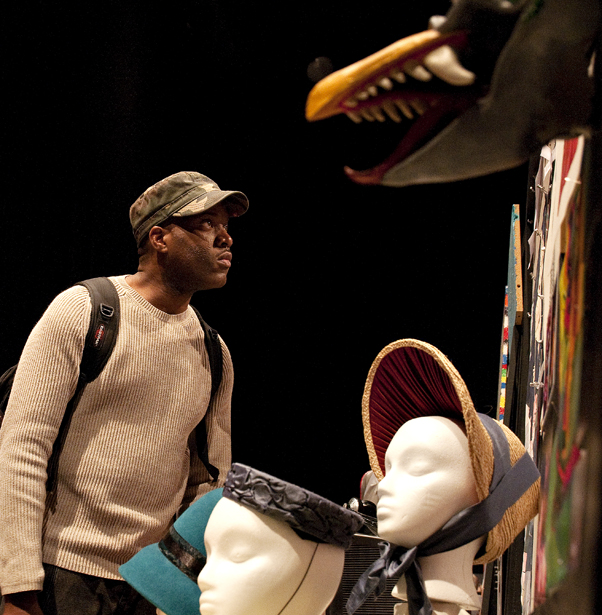A step onto the brightly lit stage of the Oscar G. Brockett Theatre is a step behind the scenes of the University’s Department of Theatre and Dance.
This week, senior undergraduate and graduate students reveal the secrets of their trades at the annual Theatre Design & Technology Spring Showcase.
The UT and Austin communities will have the opportunity to peruse the portfolios of students in programs including scenic design, lighting, costume and costume technology, and scene and theatrical design. A small sea of booths, one representing each student, provide snapshots and detailed glimpses into the artistry and effort behind previous productions from November’s “Fight” to February’s “The Threepenny Opera.” Some even provide sneak peeks of set and costume design for upcoming productions — namely, “Love’s Labour’s Lost,” an early Shakespearean comedy that will premiere April 2011.
In a corner of the upper steps of the stage, costumes hang on a rack as they would in a clothing store, and painstakingly detailed masks and bright swatches of fabric are set up across the length of a table. Several framed chalkboards encourage passers by to touch the work on display, leave messages on the boards and speak to the student who crafted it all.
The student in question is Carl Booker, a theatrical design student who will graduate from the Master’s program this year. He believes in gaining an understanding of the draping and design processes through interactivity.
“The joy, I found, is in seeing how things are made,” Booker said. “For me, I want people to look inside [my work] and ask how it’s made and try to figure it out. This work isn’t just for me, it’s for everyone — we need to share the knowledge we have. It’s a part of who we are.”
Booker’s booth allows people to look into the process of creating costumes, from hats to masks. A leprechaun mask he made based on an illustration from Tony DiTerlizzi and Holly Black’s “Arthur Spiderwick’s Field Guide to the Fantastical World Around You,” stood on display. A step-by-step set of photographs show the mask being carved and molded from latex. A closer look at the mask reveals details such as individually hand-punched hairs.
In another corner of the theater, tiny worlds of paper and mat board figurines are set up on display, each stored in its own container, not much larger than a shoebox. Beside them are sketches resembling an architect’s blueprints, and pages of research and photos, all drawn up by set design creator and first-year theater graduate student Jocelyn Pettway.
Designing every set evolves from “little kernels” of inspiration, most of which derive from focusing on what is obscure, unclear or mysterious in a piece and learning how to embody that on a single stage, Pettway said.
While creating the vast, cavernous stage design for “The Vault,” where a ’50s town on hard times is paid to turn against one of its residents, Pettway drew inspiration from pictures of Australian prisoners. The images provided an understanding of the feeling behind the idea of a single man versus society.
“They’re just mug shots, but they’re works of art,” Pettway said, pointing to a somber image of a weathered man in a hat, his eyes closed. “It comes from simple things — this man just refused to open his eyes.”
With each booth comes its own story, from creating visual art with lighting to set building, the portfolios of students come together much like the actual students do for every production — innumerable pieces mesh into a whole.
Innovative designs and projects reveal the secrets and talents behind theater productions and even beyond. Booker’s booth also features a prototype for Firsthand, an app he created with the help of an undergraduate computer science developer that is the first in a series meant to streamline the processes of theatrical costume design and costume-making.
Pettway emphasizes that the most important part of the production is what the audience contributes when experiencing the visual art majors’ works.
“An audience can do more in their head, with just their imagination, than we can ever do,” Pettway said. “It’s amazing to see how open and trusting they are in these settings. If you provide them with just a little [of a theatrical world], they do the rest.”















